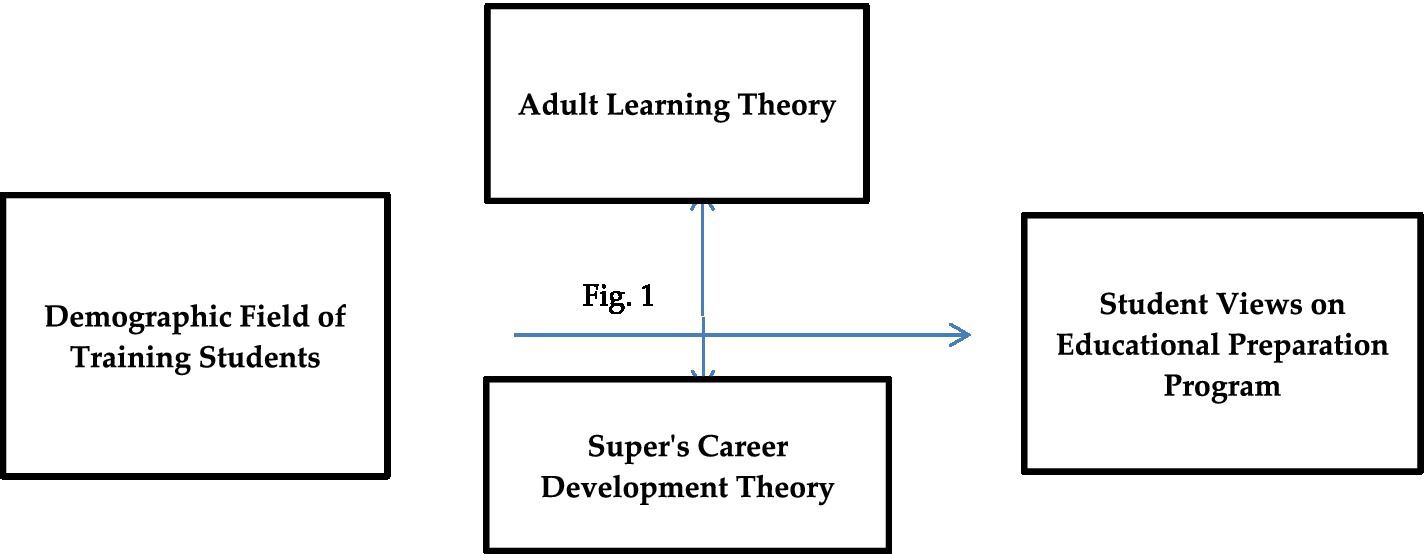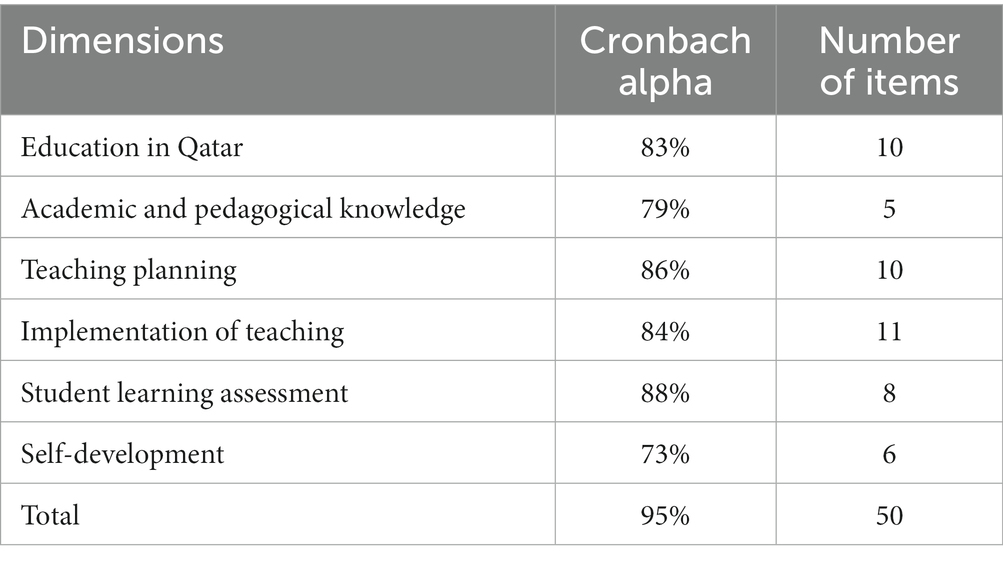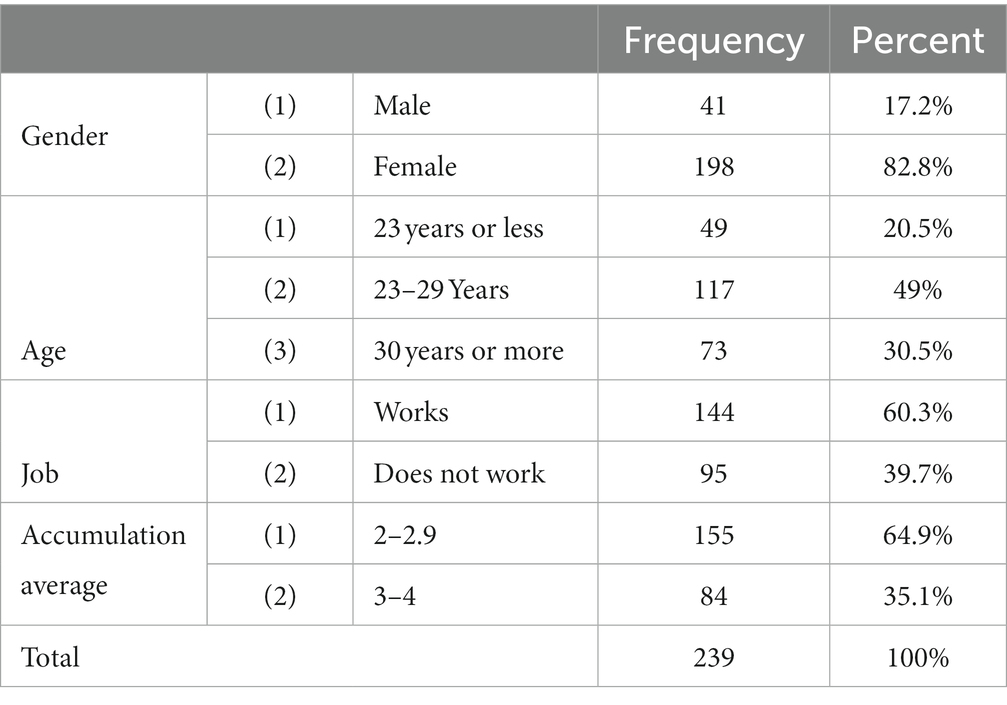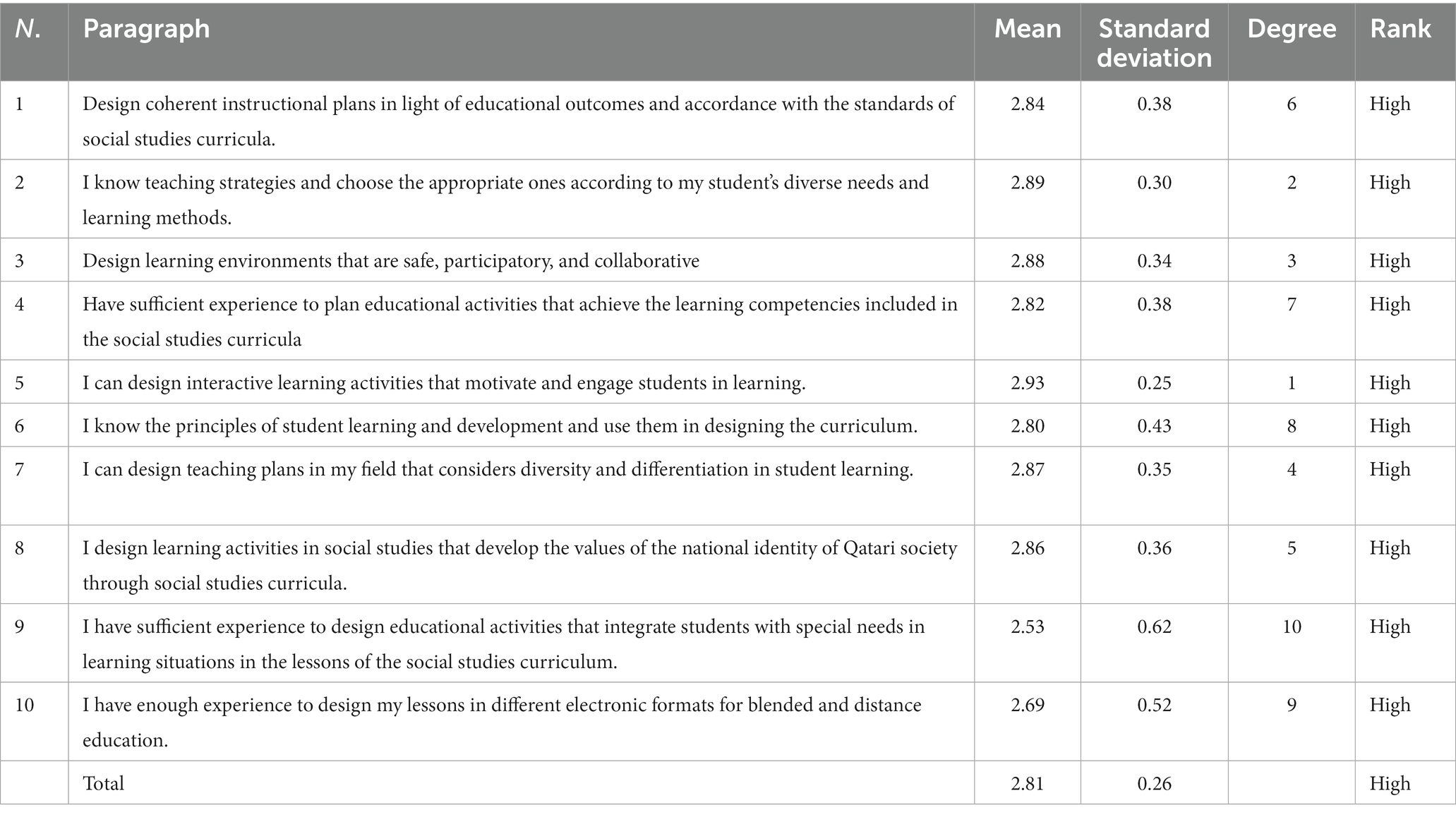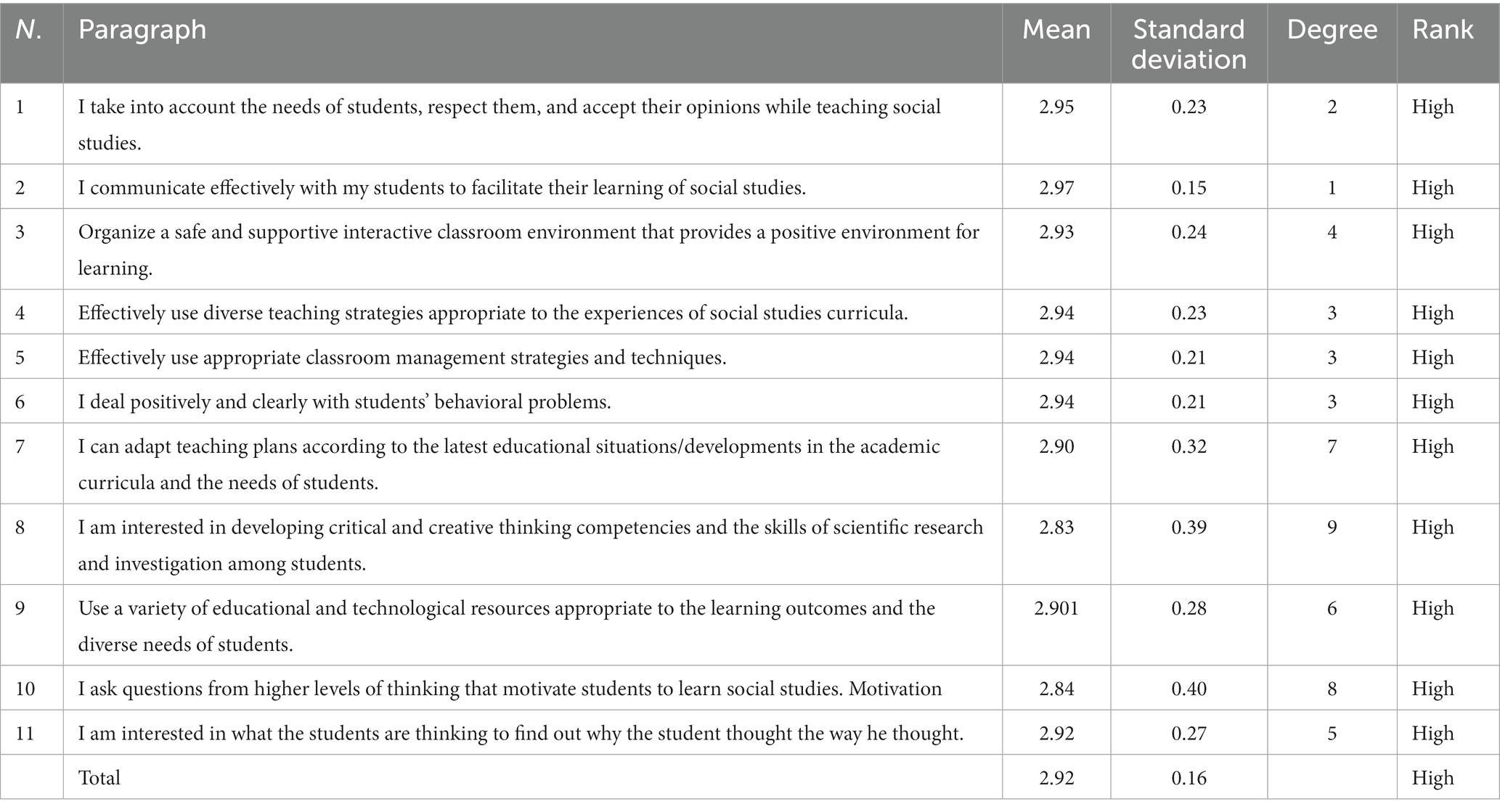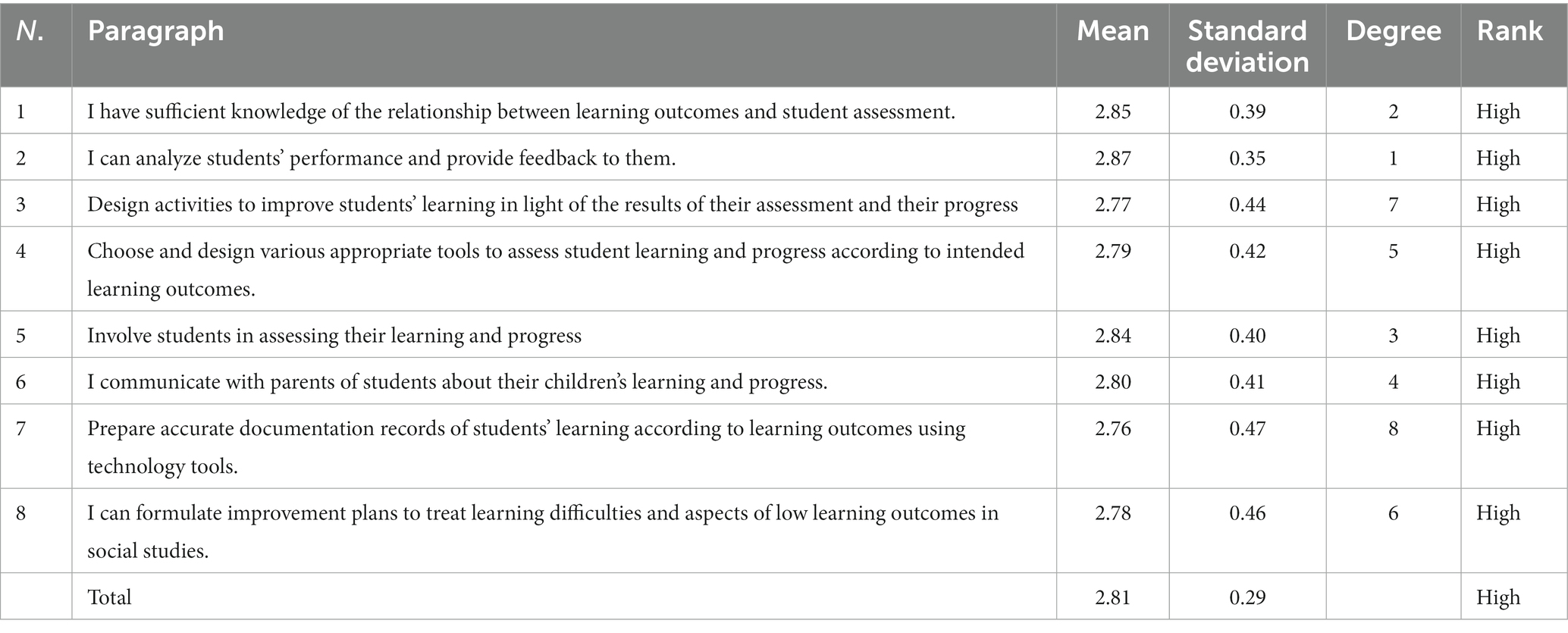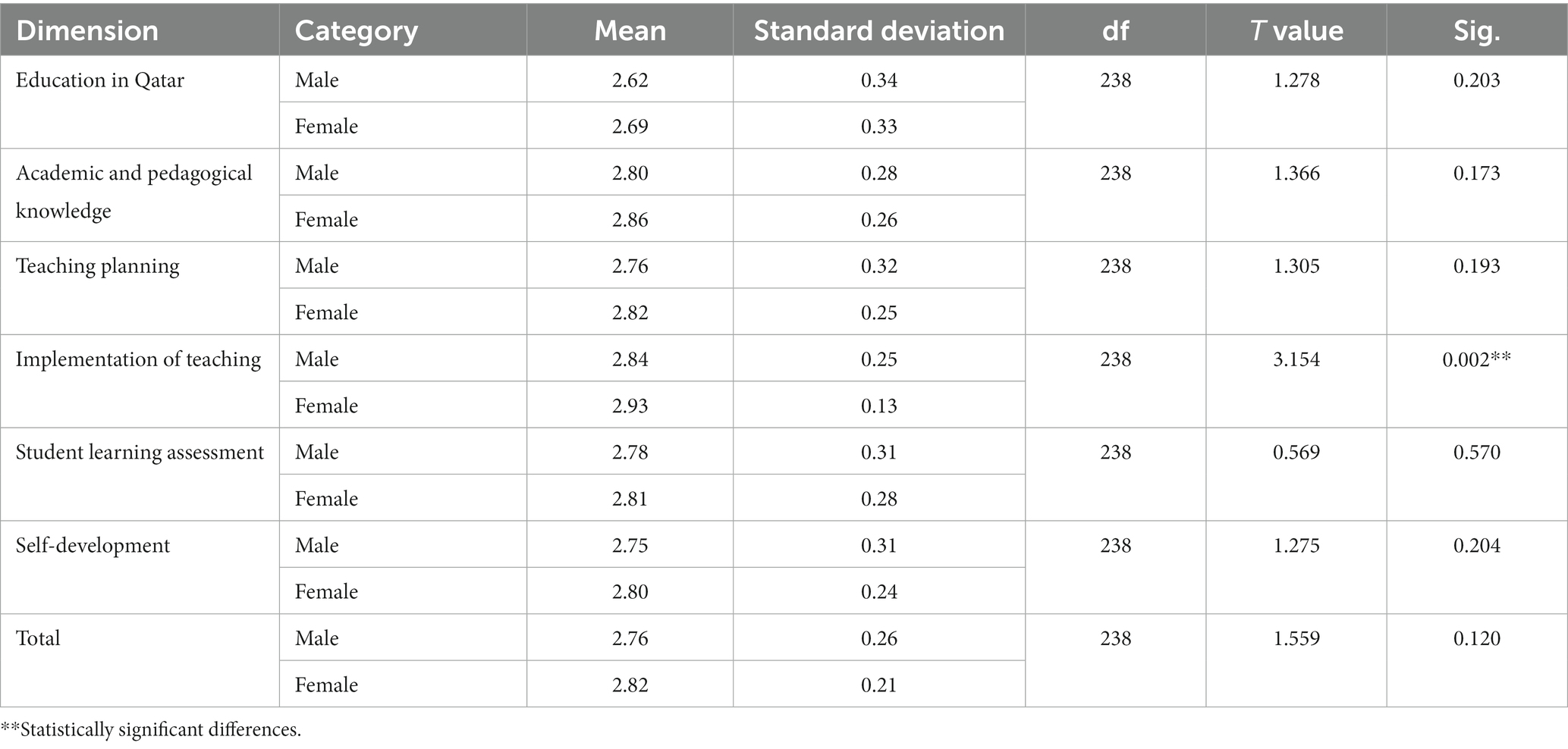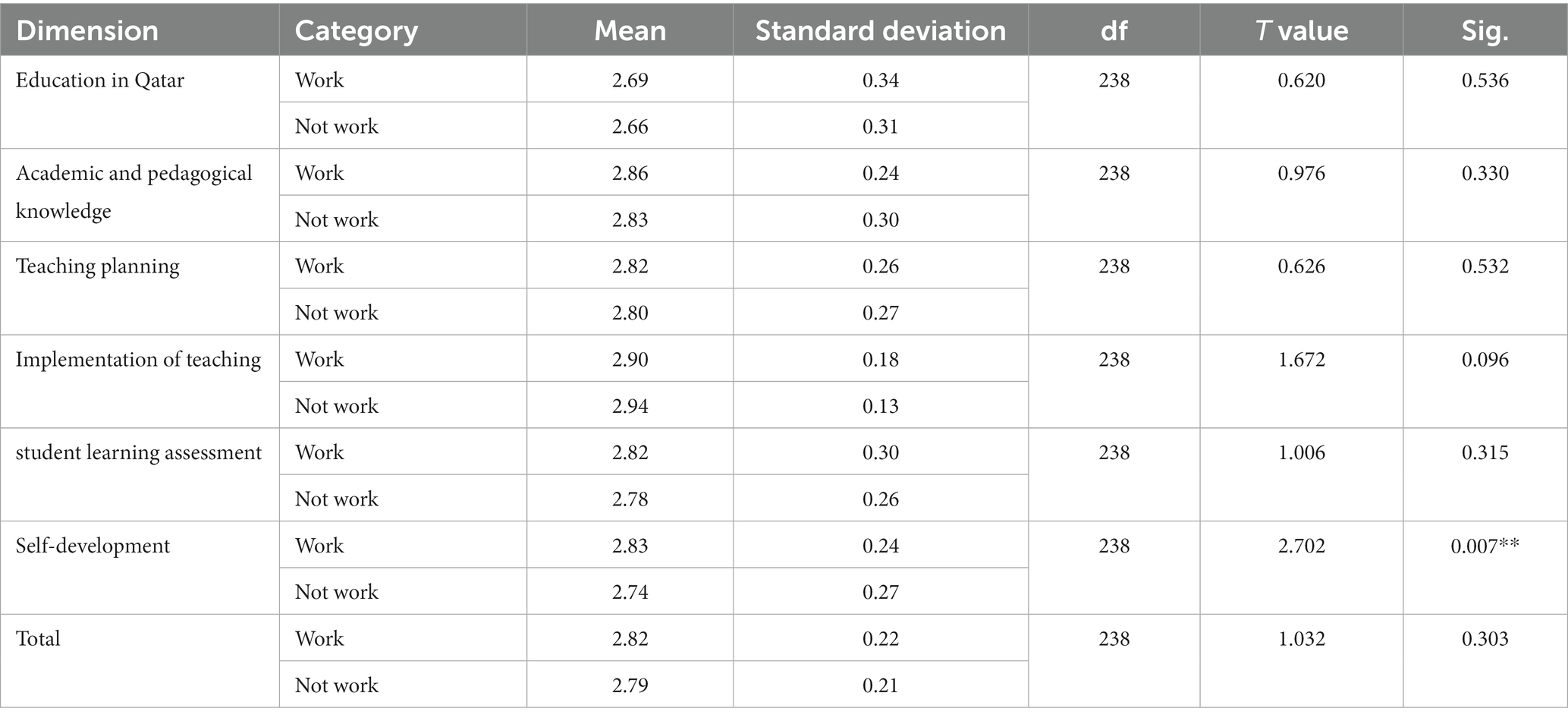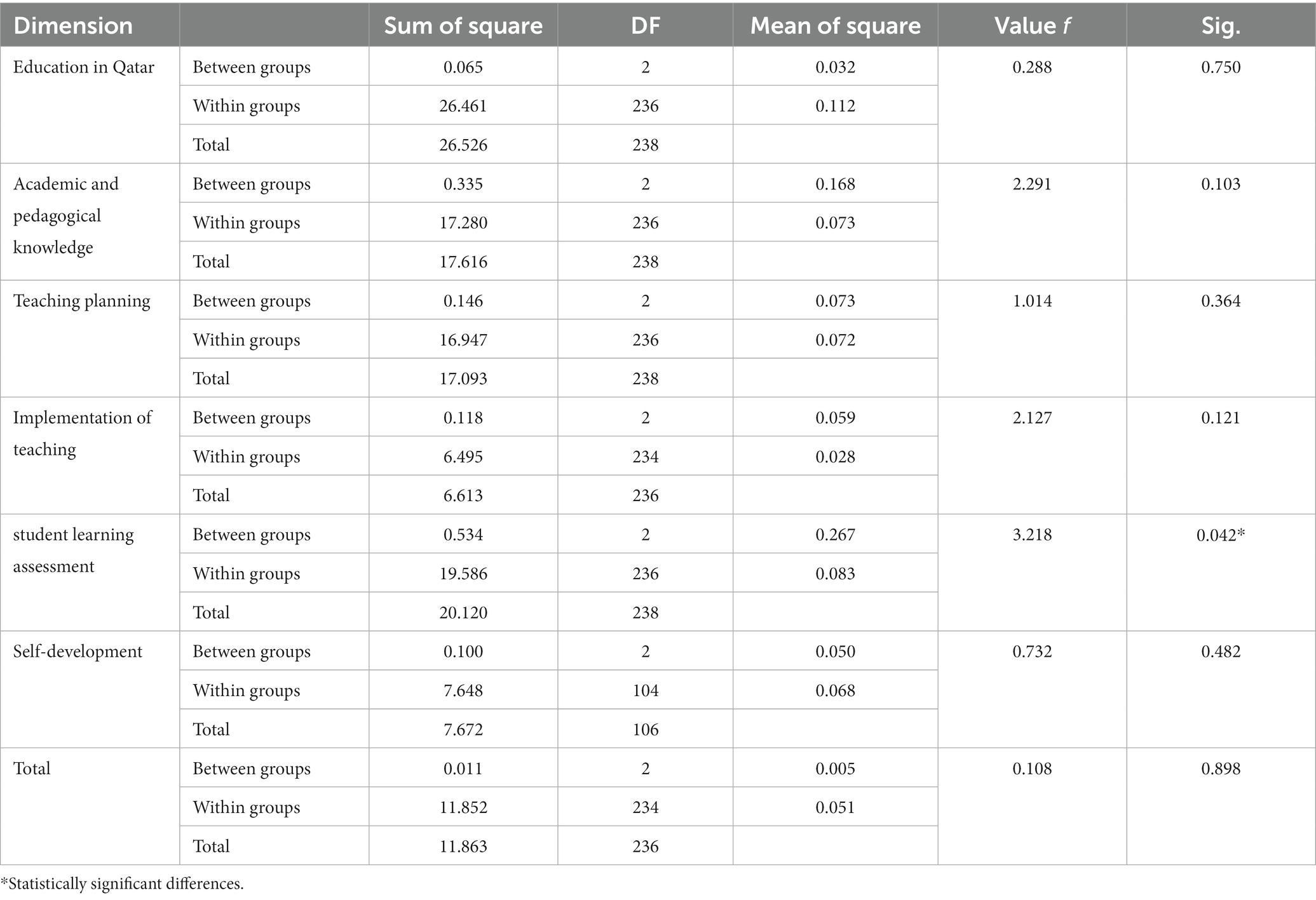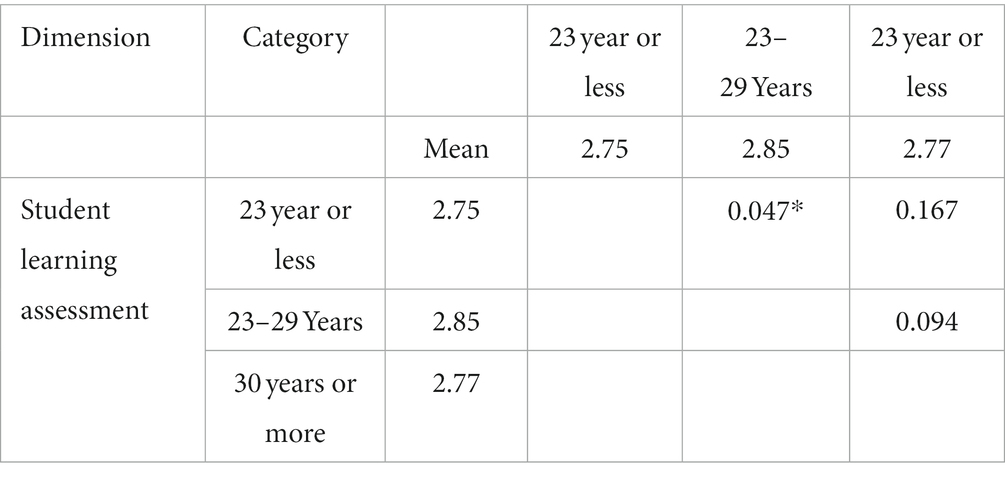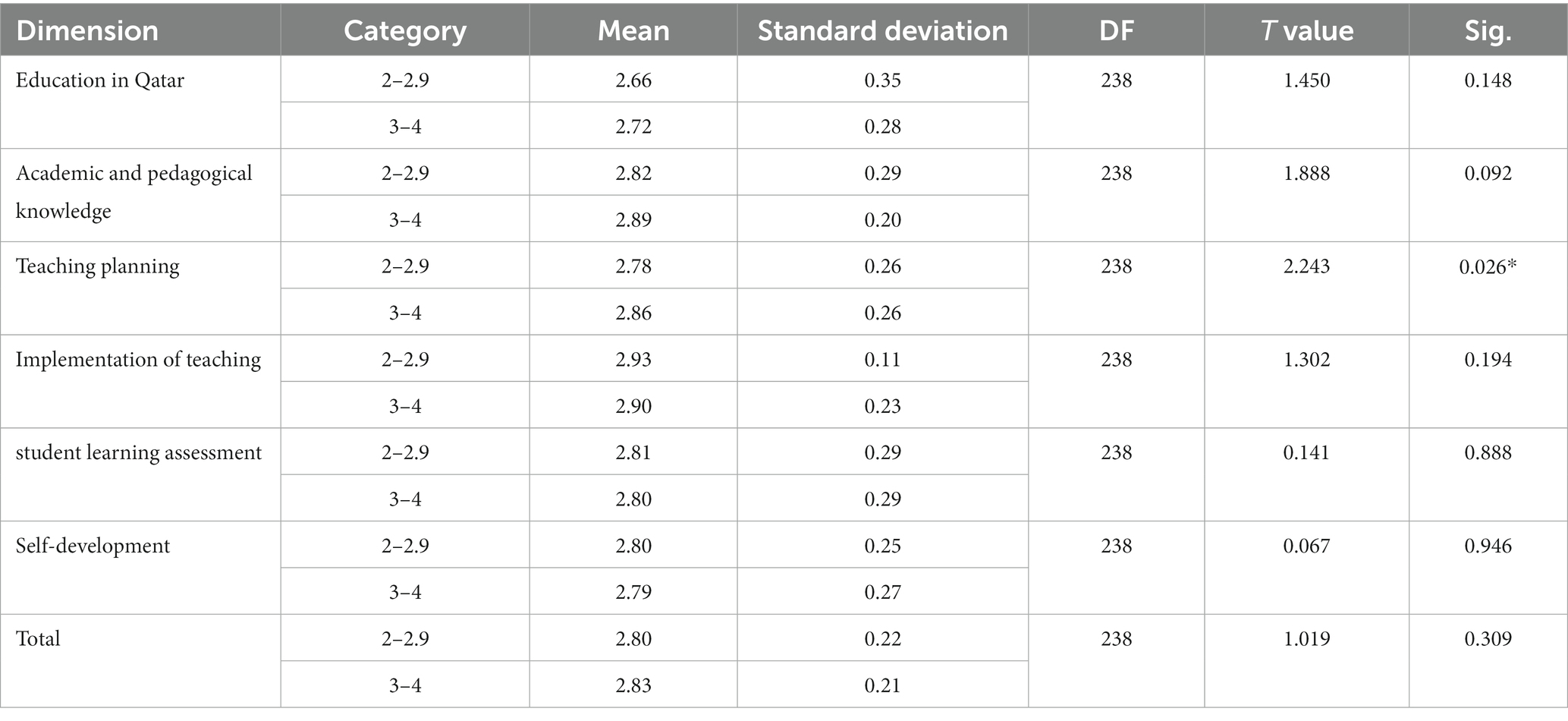- Department of Educational Sciences, Qatar University, Doha, Qatar
Introduction: The study aims to assess the students’ views in the field training about the educational preparation program in social studies at Qatar University. The research is grounded in the adult learning theory as it involves the adult learning behaviors toward an educator preparation program.
Methods: Primary quantitative research design is set up in the study to analyze the students’ views. Moreover, a questionnaire is administered to gauge the opinions on six dimensions relevant to the Educational Preparation Programs (EPP). Finally, a descriptive research approach is used where the responses from 239 males and females were both included in the study [Male = 41 (17.2%), Female = 198 (82.8%)] students teachers are analyzed. The researchers also used interviews with 30 female students to reach their opinion about the efficiency of the teacher preparation program that they studied for 4 years at the university.
Results: According to current study results, the demographic factors do not impact the views of the field-training students in the social studies about the EPP in Qatar University.
Discussion: The results raise the question of a potential that teachers’ self-efficacy and characteristics of EPP should be added in the dimensions for which the students’ views are gauged in future studies.
1 Introduction
The developments in educational systems have put significant responsibilities on the educational institutions regarding their students. Primarily, educational institutions focus on collaborating with professionals to create a bridge between themselves and real-time companies to facilitate their students. Nevertheless, educational institutions aim to prepare their students for endeavors ahead where educational preparation programs are significant. Educational preparation programs pay attention to the need of individuals while focusing on further efforts (Hendawi and Nosair, 2020). EPP prepares individuals based on information like different courses, counseling services, and other relevant information dissemination to help these individuals. The role of educator preparation programs has become essential for institutions and the students (Augustine and Krop, 2008). However, the educational systems are not advanced equally within all countries; in this regard, the educational system in Qatar has an exciting story.
Qatar is a highly developed country and is considered the third most prosperous country globally, while the revenues from oil exports significantly constitute development in the country. The modern educational system in Qatar is relatively new; nonetheless, the government’s focus on the educational system is remarkable (Saif and Kamal, 1983). The first secular primary schools opened in 1952, shortly after the oil exports began in Qatar. With the tremendous efforts of the Qatar government, by the 1980s, the educational system developed well. Besides, the students can choose to go for technical, vocational, commercial, and religious training at secondary levels of education. In this regard, educational preparation programs by the education institutions are relatively new, and educational systems are still working on them (Brewer et al., 2007). Therefore, the effectiveness of these academic preparation programs for the students remains a mystery in Qatar.
Education in Qatar is a priority for the Qatari government, and significant investments have been made to develop a robust education system. The education system in Qatar is based on the Qatari National Vision 2030, which aims to build a knowledge-based society. Education in Qatar encompasses all levels, including early childhood education, primary education, secondary education, and higher education. The government provides free education for Qatari citizens from kindergarten to university, and there are both public and private educational institutions in the country.
The government in Qatar put significant efforts into ensuring improvement within their educational systems, whether it is about the learning process of students or preparing them for further studies and professional opportunities. Therefore, the role of academic preparation programs for the educational system in Qatar within this context is essential. Currently, educational institutes provide the services of Educational Preparation Programs (EPP). Still, their effectiveness for the students is not known yet from student evaluation regarding EPPs (Greenberg et al., 2013). However, previous studies on the efficacy of EPPs considered case studies are limited, and this aspect proposes a gap in the research. Thus, this study identifies this gap in the previous research related to this field and aims to explore this further in the current research study.
1.1 Aim of the study
This study identifies the gap in research and explores the EPPs within the educational institutes of Qatar. Keeping this in mind, the study examines the effectiveness of academic preparation programs in-field training students specializing in social studies at Qatar University.
1.2 Research questions
The study further translates its aim into research questions which sets a clear direction for the current research study. These research questions are highlighted as follows;
What is the viewpoint of students regarding field training majoring in social studies on the effectiveness of their educational preparation program at Qatar University?
Do social studies field training students’ views on the effectiveness of the educational preparation program at Qatar University differ according to gender?
Do social studies field training students’ views on the effectiveness of the educational preparation program at Qatar University differ according to their job status?
Do social studies field training students have different views on the effectiveness of educator preparation programs at Qatar University according to their age?
Do social studies field training students have different views on the effectiveness of educator preparation programs at Qatar University according to cumulative average?
1.3 Significance of the study
This study focuses on the Educational Preparation Program (EPP) effectiveness from field training students specializing in social studies at Qatar University. The importance of the research stems from interested in the preparation and ongoing support of teachers, as well as to have a significant voice in discussions and decision-making about teacher education issues. it is very important to identify and address the increasingly complex issues confronting teacher education at the national and global levels, These issues include teacher preparation to effectively address the needs of marginalized youth, their families, and communities; program design and impact; teacher selection, recruitment, and retention of teachers from underrepresents groups; local and national policy; accountability; and routes to certification.
As the modern educational system in Qatar is relatively recent, there are limited studies that have catered to the need for research regarding EPP within the educational sector; this study will contribute significantly to the previous literature in this regard. The study’s findings will provide essential insights into the relationship between the views of field training students on the effectiveness of EPP and their demographic characteristics.
1.3.1 Practical implications
Conducting the current study has various practical implications.
The study provide insights into the success of the Practical Education Program, thereby improving educational quality and enriching students’ experiences and understanding how students react to the Practical Education Program can help them improve their academic experience while also increasing their practical skills.
The study highlight the Practical Education Program’s strengths and shortcomings, allowing the college to focus on boosting positive parts and improving areas that may require growth and evaluating the success of the Practical Education Program can assist in ensuring that students’ gained skills are relevant to the needs of the local job market.
2 Literature review
To achieve the aim of this study, this section focuses on evaluating previous literature. The exploration of previous literature allows the assessment of other researchers’ theoretical and empirical underpinnings regarding the effectiveness of EPPs. Finally, this section provides information about the theoretical framework of the current study.
2.1 Theoretical framework
The theoretical framework for this research study has been presented in Figure 1 that includes the Independent Variable (Demographic field of training students) and the Dependent Variable (Student views on Educational Preparation Program).
2.1.1 Hypothesis establishment
H1: There is a direct and positive relationship between the Demographic field of training students and Student views on the Educational Preparation Program.
H2: The association between dependent and independent variables has been linked by Adult Learning Theory and Super's Career Development Theory.
2.1.2 Educational preparation program
A recent literature search in educator preparation programs reveals limited studies. It was found that Traditional educational preparation programs are criticized for their theoretical grounding in behavioral psychology principles. Keedy (2005) believes that the positivism approach of the 19th century is entirely different from the technical rationality approach of the 20th century. He highlights that the impact of these approaches has led to a split between theoreticians and practitioners. This impact also demonstrates a need for new theoretical underpinnings for studying the effectiveness of educator preparation programs.
Kanan and Baker (2006) have conducted a research study to assess the effectiveness and satisfaction of the students regarding the Educational Administration Preparation Program (EAPP) in Palestinian universities. Researchers in the context of EAPP have discussed the global theory. They have employed a qualitative research method and interviewed 23 students to assess their perception of the topic under study. The study’s findings exhibited that students’ satisfaction is linked with “interpersonal interaction” irrespective of EAPP. On the other hand, 31% of respondents agreed that the program was highly effective. The program’s effectiveness is 61% with regards to improving communication skills. But the program has failed to improve and develop the students’ problem-solving and political leadership skills (Roach and Lemasters, 2006). Therefore, it can be inferred that EPP has effectively improved students’ communication skills. Within this context, it was observed that the use of the qualitative research method had entailed a limitation in this research study.
A research study by Henderson et al. (2006) evaluated the perception of preceptors toward Educational Preparation Programs (EPP) and the role of organizational support. The target population of this research study is nurses (provided with two-day Educational Preparation Programs). Researchers have employed a qualitative research method and collected the data from nurses at different time horizons (one time after 3 months, and the second time after 6–9 months) from 36 registered nurses regarding the topic under study. The underlying aim here is to assess the significance of EPP. The study’s findings exhibited that preceptors find EPP programs effective in providing them learning exposure to discharge their job duties at hospitals and clinics (Henderson et al., 2006).
Moreover, the research findings recommended that EPP with proper scheduling, sufficient time for the learning exposure, immediate feedback to preceptors, and necessary organizational support. Hence, EPP is building competencies in the preceptors through administrative support aspects. Using qualitative research method and longitudinal time-horizon in gathering data from the target population has added to the limitations of this research study.
A research study conducted by Subramaniam and Monogaran (2023) addressed concerns among Malaysian employers about the readiness of university graduates for the job market. It focuses on evaluating skills acquisition among interns at a Malaysian public university through skills gap and radar analyses. The participants include students from the Arts and Social Sciences faculty who underwent internships and the employers responsible for their training. The study, involving 164 students and 43 employers, identifies a notable gap in ‘values, attitudes, and professionalism’ between employers’ expectations and interns’ performance, emphasizing these as crucial for employability. Positive attributes like strong work habits are highlighted, and improvement is recommended in ‘communication, leadership, and team skills’ to enhance employability. The dual-perspective analysis provides valuable insights for reshaping university modules to better meet the expectations of potential employers.
In a study conducted by Mustarihi (2020) aimed to identify the obstacles to field training facing female students in the College of Education in Saudi universities from their point of view, and to indicate whether these obstacles are due to the student himself, to the academic supervisor, to the cooperating teacher, or to the school. A study was conducted using the descriptive analytical method and a four-dimensional questionnaire was prepared, containing (28) items. The results of the study showed that the obstacles to field training in the college of education in Saudi universities, which relate to the students themselves and to the academic supervisors, were at a moderate level. As for the obstacles The obstacles related to the field supervisor and the school were at a high level, and the highest degree of obstacles were those associated with field supervisors, and the least were related to academic supervisors. The study also showed that the obstacles in general were at a moderate level.
The study conducted by Fawzi et al. (2020) aimed to determine the components of procedural research designed by nominated art education students in partner schools during field training practices, and to reveal the impact of the nominated students’ application of procedural research on the performance of their students in field training practices, and also to measure the attitudes of candidates and students toward the components of procedural research. And its roles in enriching thought and knowledge in contemporary art education practices. These goals were linked to the nature of the CAEP standards system and its emphasis on the impact of the student teacher preparation program on the learning and development of students in schools. In order to do this, the researchers built two research tools, which are a measure of the orientation of the nominated students toward action research applications during field training in schools, where the scale included (40) items distributed on four main axes, and a questionnaire that measured the students’ attitude toward the applications of action research and their level of interest toward the idea of research and toward the subject. In general, the scale included (26) items that required a response from these learners after completing the action research activities with them. The most important results of the study resulted in several aspects of procedural research that can contribute to developing teaching and learning methods in the fields of art education. The study recommended several recommendations, the most important of which was working to align action research with the outcomes of the specialized art education program.
The providers of the educator preparation programs have to consider the perspectives of training students that foster their learning, growth, and development. For example, a theory called “Adult Learning Theory ALT,” or “Andragogy” provided by Malcolm Knowles in 1968 supported the stance mentioned above (Merriam, 2018). The theory exhibited that every adult or child learns differently. The argument derived from the ALT theory presented that adult learning differs from one person to another. Hence, the training providers have to ensure person-specific learning styles that best match their needs and personality. ALT has been comprised of five assumptions that need to be fulfilled to provide effective EPP from the point of view of field training students (Halalau et al., 2016). One belief, “Self-concept,” entails that students prefer to learn that provides the opportunity to self independently do so irrespective of the dependent learning that hinders their growth and development (Brockett and Hiemstra, 2018). This assumption is linked with the topic under study, as if providers of the EPP will adopt a self-directed approach, then EPP will be more effective as a result. Hence, it can be inferred that self-concept should be practiced by the trainers of EPP to be made more effective for the field training students.
Another assumption “adult learning experience” can be beneficial in making EPP effective for the field training students. The significance of this assumption has been found that every adult experiences differently (Arghode et al., 2017). The trainer has to learn from their experiences and mold their training aspects while considering the field training students. Moreover, field training students are more prone to readiness if it is meant for personal growth or development (Kelly, 2017). Another assumption of ALT exhibited that if learning would be readily applicable in the daily lives of field training students (provides a solution for problem-solving and efficient working), then EPP programs will be more effective as a result (Merriam, 2018). Furthermore, ALT had entailed the motivation factor that stated that there would be more effective learning when learning is backed up by self-esteem, self-efficacy, and self-actualization (Malik, 2016). Hence, it can be inferred that if trainers provide an adult learning experience, readiness, orientation, and motivation for learning, then EPP would be more effective for field training students.
Demographics of field training students and Education Preparation Programs are linked together by a theory called “Super Theory of Career Development.”t.” Donald Super presented the view in 1996 (Kosine and Lewis, 2008). The concept of super-professional development shows that the stages of development and research are gaining knowledge of how well a person’s needs and skills meet the professional standards. All high school students are at the forefront of advanced training (Zacher et al., 2019). The process of professional development of each person is unique. Factors such as gender, ethnicity, ability, personality, social, job status, economic status, family, geography, and opportunities play a significant role in a person’s career development (Swanson and Fouad, 2014). They influenced career development in either a positive or a negative way. In a nutshell, demographic factors of field training students significantly influenced the effectiveness of EPP.
The work of Super and his colleagues has predominantly shifted the focus of choosing a profession from the occurrence of statistical time to the dynamic process of career development. Moreover, many factors have been assessed from Super’s theory that influenced social learning practices, personal growth, and career development (Kosine and Lewis, 2008). Super’s career development theory comprises advanced development and social role theory, which shows that people move in five stages in the professional development process, including growth, search, creation, maintenance, and cessation (Sharf, 2016; Nosair et al., 2021). Hence, Super’s career development theory has provided a stance on how EPP programs could be more effective for the field training students.
All the mentioned research studies have linked to the topic under consideration, that is, “The effectiveness of educator preparation program from the point of view of field training students, specializing in social studies.” These research studies have provided options for making EPP effective by linking it with ALT and Super’s career development theory.
2.2 Literature gap
The mentioned gap in the research studies of Henderson et al. (2006) and Kanan and Baker (2006) will be overcome in this research study by using a quantitative research method and a cross-sectional time-horizon used in this research study. Hence, the mentioned research gaps will be overcome in this research study.
3 Materials and methods
3.1 Declarations
This cross-sectional study followed the guidelines and the Declaration of Helsinki, and the protocol was approved by the universities institutional review board approval number (QU-IRB 1340-EA/20.)
3.2 Sample
The study sample is based on students enrolled in the social studies faculty at Qatar University during the academic years 2018/2022. There were 292 students enrolled in the study period of 4 years within the social studies faculty at Qatar University. Among the total sample (N = 239), males and females both were included in the study [Male = 41 (17.2%), Female = 198 (82.8%)].
3.3 Instrument and variables of the study
Mixed methods were used to collect data. Questionnaires and interviews were used to collect data. The data is collected using a questionnaire based on 50-items. These 50 items demonstrate statements from six different dimensions. These dimensions are Education in Qatar, Academic and pedagogical knowledge, teaching planning, Implementation of teaching, student learning assessment, and self-development. The researcher reviewed many studies in the field before designing the questionnaire, including Hassan &Munir. (2017), Jafar (2017), Zamil (2017), Aljassar and Altammar (2019), Al-Jameel (2020), Al-Rashdan et al. (2020), Fawzi et al. (2020), Itmeizeh and Jaradat (2020), Mahmoud (2020), Qadhi et al. (2020), and Ahmed Burayk (2021). These items are built on a 3-point Likert scale for recording students’ views (1 = disagree, 2 = not sure, 3 = agree).
3.4 Reliability and validity
The validity of the questionnaire and interviews are ensured by presenting the tool to individual judges, including individuals who specialize in the education field and faculty members of universities and teachers. The arbitrators’ views on items included within the study were satisfactory, and the percentage of people agreeing to the suitability of the questionnaire paragraph was more than 90%. This percentage demonstrates that items included in the questionnaire are acceptable and reasonable.
To address potential response bias and enhance the validity of research tool, the following considerations taken into account:
− Ensure that survey questions are phrased in a clear and unbiased manner to minimize misinterpretation.
− Ensure that survey questions are phrased in a clear and unbiased manner to minimize misinterpretation.
− Randomize the order of survey questions to mitigate response order bias and reduce patterns in participant responses
− Integrate validation measures or checks within the survey to identify participants who may be providing inconsistent or socially desirable responses
− Analyze and understand potential biases introduced by participants who chose not to respond.
To assess the reliability of the questionnaire Cronbach Alpha is calculated. The results for Cronbach Alpha are presented in the table below for each dimension.
Table 1 shows coefficients of Cronbach Alpha for all dimensions. These results demonstrate internal consistency across the dimensions regarding students’ views on the Educational Preparation Program. The coefficients of Cronbach Alpha are all within the acceptance range, i.e., more than 0.65 (Tavakol and Dennick, 2011). Therefore, it shows that the study results can be generalized based on data collected through this questionnaire. In addition, the summary of demographic variables is presented in the table below.
The results of the demographic data analysis (frequencies and percentages) in Table 2 shows that (17.2% [n = 41]) of the samples are male’s versus (82.8% [n = 198]) who are females.
For the age variable, the highest percentage is (49% [n = 117]) which is assigned for the 23–29 Years group, followed by the age group 30 years or more Years with around (30.5% [n = 73])., followed by the age group 23 year or less with around (20.5% [n = 49]).
For the job variable, a working category got (60.3% [n = 144]), while a non-working category got (39.7% [n = 95]).
For the Accumulation average variable, a 2–2.9 category got (64.9% [n = 155]), while a 3–4 category got (35.1% [n = 84]).
The researcher adopts a descriptive approach for measuring the effectiveness of social studies EPP in-field training students. To answer the research questions of this study, an independent sample t-test is used for identifying statistical differences between the categories (based on demographics).
4 Results
The study results are based on a descriptive approach that includes the mean, standard deviation, rank, and degree for all dimensions. An overall effect is identified while simultaneously considering the descriptive measures for all dimensions. The overall effect suggests that field training students agree with the effectiveness of the Educational Preparation Program in social studies. Aside from that, the analysis reveals no difference in students’ views on the effectiveness of the social studies Educational Preparation Program based on their gender, age, job status, and a cumulative average GPA. However, the study’s findings reveal that demographic characteristics do not influence the views of field training students regarding EPP at Qatar University.
To answer the main question, what is the effectiveness of the educational preparation program at the College of Education from students of field training majoring in social studies at Qatar University? The mean, standard deviation, rank, and degree for each dimension are calculated.
Table 3 appears that the means with a high rank for the dimensions of the overall study and the total study mean (2.81) with a high level and a standard deviation of (0.23).

Table 3. Means and standard deviations of the effectiveness of the educational preparation program at the College of Education from the viewpoint of students of field training majoring in social studies at Qatar University.
The fourth dimension (Implementation of teaching) is the first degree with a mean (2.92) with a high rank and a standard deviation (0.17).
The first dimension (Education in Qatar) is the last degree with a mean (2.68) with a high rank and a standard deviation (0.33).
To answer the first sub-main question, what is the view of field training students majoring in social studies on the effectiveness of their educational preparation program at Qatar University? The mean, standard deviation, rank, and degree for each dimension are calculated.
Table 4 appears that the means in a high rank for the paragraph of the Education in Qatar dimension, total mean of the Education in Qatar is (2.68) in a high level and a standard deviation of (0.33).
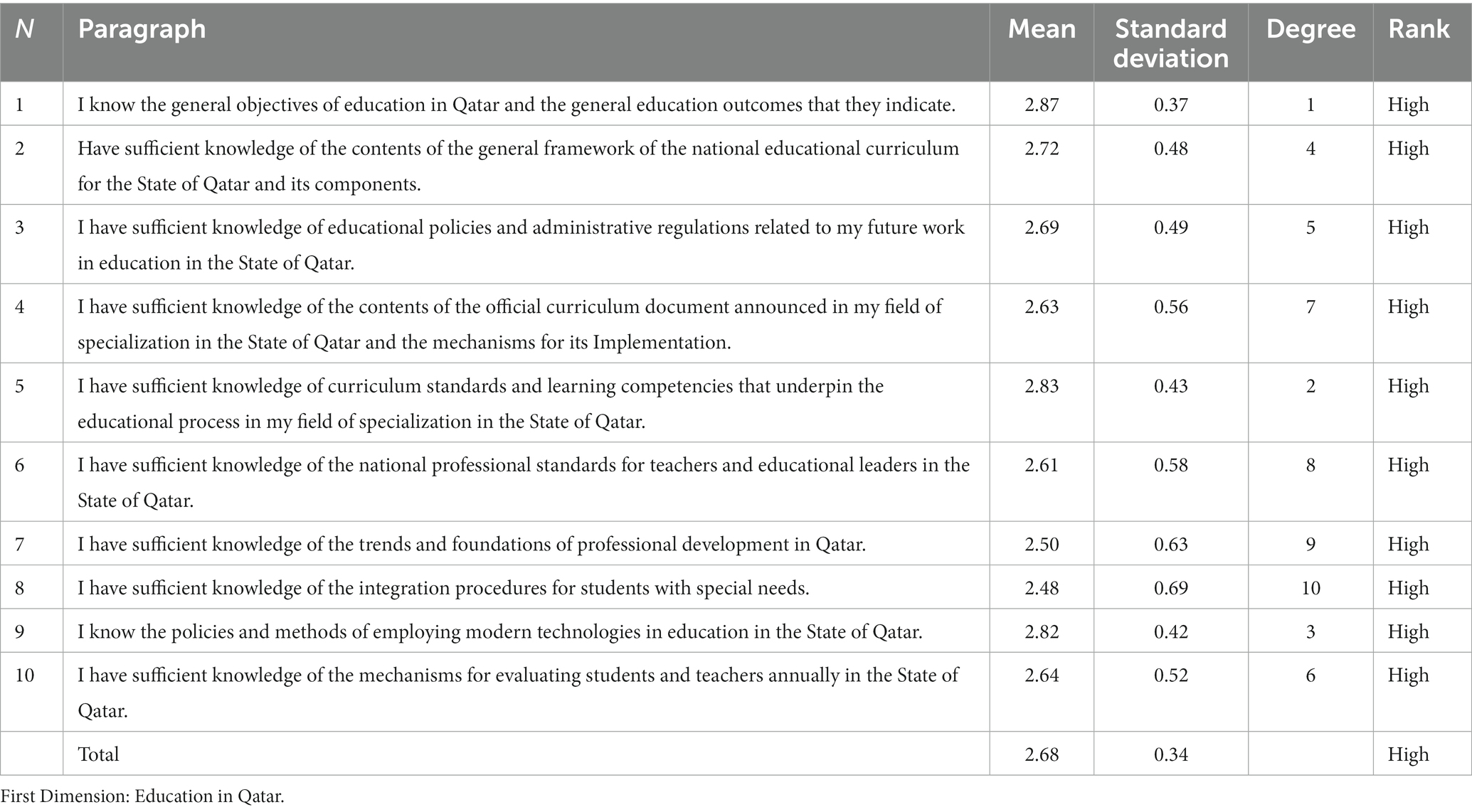
Table 4. Means, standard deviations, degree, and rank of view of field training students majoring in social studies on the effectiveness of their educational preparation program at Qatar University, for each dimension.
The first paragraph (I know the general objectives of education in Qatar and the public educational outcomes that they indicate) is in the first degree with a mean (2.87) with a high rank and a standard deviation (0.37).
The eighth paragraph (I have sufficient knowledge of the integration procedures for students with special needs) in the last degree with a mean (2.48) with a high rank and a standard deviation (0.69).
Table 5 appears that the means in a high rank for the paragraph of the Academic and pedagogical knowledge dimension, total mean of the Academic and pedagogical knowledge is (2.85) in a high level and a standard deviation of (0.27).
The fifth paragraph (I have a clear understanding and knowledge of my own beliefs for teaching and learning) is the first degree with a mean (2.94) with a high rank and a standard deviation (0.26).
The first paragraph (I understand the scientific structure of the main concepts and basic ideas of the academic specialization in which I work and the relationships and interconnections between them.) in the last degree with a mean (2.76) with a high rank and a standard deviation (0.42).
Table 6 appears that the means in a high rank for the paragraph of the Teaching planning, total mean of the Teaching planning is (2.81) in a high level and a standard deviation of (0.26).
The fifth paragraph (I can design interactive learning activities that motivate and engage students in learning) is the first degree with a mean (2.93) with a high rank and a standard deviation (0.25).
The ninth paragraph (I have sufficient experience to design educational activities that integrate students with special needs in learning situations in the lessons of the social studies curriculum.) in the last degree with a mean (2.53) with a high rank and a standard deviation (0.62).
Table 7 appears that the means in a high rank for the paragraph of the Implementation of teaching, total mean of the Implementation of education is (2.91) in a high level and a standard deviation of (0.16).
The first paragraph (I take into account the needs of students, respect them, and accept their opinions while teaching social studies) came in the first degree with a mean (2.95) with a high rank and a standard deviation (0.23).
The eighth paragraph (I am interested in developing the competencies of critical and creative thinking and the skills of scientific research and investigation among students) in the last degree with a mean (2.83) with a high rank and a standard deviation (0.39).
Table 8 appears that the means in a high rank for the paragraph of the student learning assessment, total mean of the student learning assessment is (2.81) in a high level and a standard deviation of (0.29).
The second paragraph (I can analyze students’ performance and provide feedback to them) is the first degree with a mean (2.87) with a high rank and a standard deviation (0.35).
The seven paragraph (Prepare accurate documentation records of students’ learning according to learning outcomes using technology tools.) in the last degree with a mean (2.76) with a high rank and a standard deviation (0.47).
Table 9 appears that the means in a high rank for the paragraph of the Self-development, total mean of the Self-development is (2.79) in a high level and a standard deviation of (0.26).
The first paragraph (I am interested in raising my academic and educational level in the field of social studies) is the first degree with a mean (2.95) with a high rank and a standard deviation (0.20).
The sixth paragraph (I have enough knowledge of different types of meditation) is the last degree with a mean (2.53) with a high rank and a standard deviation (0.58).
Second main question: To answer the second main question about field training, students vary for social specialty in the effectiveness of the educational preparation program at Qatar University by changing sex.
An independent sample t-test was selected to find statistically significant differences between the study variables depending on the sex variable (Table 10).
The table appear that there are statistically significant differences in fourth dimension (Implementation of teaching) of the study because the value of the significance level was lowest than (0.05) depending on the gender variable, these differences was tending to “female” category with highest mean (2.93) and the “male” category with lowest mean (2.84).
The table appear that there are no statistically significant differences in other dimensions of the study between the category “male” and the category “female,” because the value of the significance level was higher than (0.05) depending on the gender variable.
Third main question: To answer the third main question, do the views of field training students vary for social specialty in the effectiveness of the educational preparation program at Qatar University by the varying job?
An independent sample t-test was selected to find statistically significant differences between the study variables depending on the job variable (Table 11).
The above table appear that there are statistically significant differences in sixth dimension (Self-development) of the study because the value of the significance level was lowest than (0.05) depending on the gender variable, these differences was tending to “work” category with highest mean (2.83) and the “not work” category with lowest mean (2.74).
The above table appear that there are no statistically significant differences in other dimensions of the study between the category “work” and the category “not work,” because the value of the significance level was higher than (0.05) depending on the jop variable.
Fourth main question: To answer the fourth main question, do the views of field training students vary for social specialty in the effectiveness of the educational preparation program at Qatar University by changing age?
One way ANOVA test was selected to find statistically significant differences between the variables of the study depending on the age variable (Table 12).
The above table appear that there are statistically significant differences in fourth dimension (student learning assessment) of the study because the value of the significance level was lowest than (0.05) depending on the age variable, also, The above table appear that there are no statistically significant differences in all dimensions of the study, because the value of the significance level was higher than (0.05) depending on the job variable, shafee test was extracted for means differences.
The table appear that there are differences in fourth dimension (student learning assessment), these differences was tending to “23 year or less” category with highest mean (2.85), while the “23–29 Years” category with lowest mean (2.75).
Fifth main question: To answer the fifth main question, do the views of field training students vary for social specialty in the effectiveness of the educational preparation program at Qatar University by changing the Accumulation average?
An independent sample t-test was selected to find statistically significant differences between the study variables depending on the Accumulation average (Table 13).
The above table appear that there are statistically significant differences in third dimension (Teaching planning) of the study because the value of the significance level was lowest than (0.05) depending on the Accumulation average variable, these differences was tending to “3–4” category with highest mean (2.86) and the “2–2.9” category with lowest mean (2.78).
the above table appear that there are no statistically significant differences in other dimensions of the study between the category “2–2.9 “and the category “3–4 “, because the value of the significance level was higher than (0.05) depending on the Accumulation average variable.
4.1 Interviews analysis
To gain insight into the perspectives of students majoring in social studies at Qatar University regarding the effectiveness of their educational preparation program, a series of interviews were conducted with 30 students. These interviews aimed to uncover their experiences, perceptions, and opinions concerning various aspects of their program. Several key factors emerged as central to their evaluation of the program’s effectiveness. Students emphasized the importance of a curriculum that aligns with the practical skills and knowledge necessary for their future careers in social studies. Additionally, the quality of instructors played a pivotal role in shaping their educational experiences, with effective teaching methods and a conducive learning environment being highly valued. Field training experiences were viewed as invaluable, providing students with practical skills, real-world exposure, and networking opportunities. Access to resources, including libraries and research facilities, was cited as essential for academic success. Support services, such as academic advising and career counseling, significantly influenced students’ satisfaction. Collaborative learning opportunities, feedback mechanisms, and a commitment to diversity and inclusion further enhanced the program’s overall quality. Ultimately, students regarded the program positively, particularly for its direct relevance to future careers and its commitment to continuous improvement through feedback mechanisms and inclusivity.
5 Discussion
It is imperative to understand the findings of this study in light of previous literature on the matter and theoretical underpinnings of the current study. This study explores students’ views in six dimensions, explained in two broad theories, i.e., adult learning and self-development. According to the adult learning theory, being at a mature stage in life, adults are more secure regarding self-concept. Self-concept allows these adults to direct their learning process. Regarding the findings, students view EPP in social studies as effective, implying that EPP is designed for encouraging students to lead their learning process. To discuss the different dimensions of student views, these dimensions can be categorized under the theoretical pinning of adult learning and self-development theory. Finally, this section of the study presents a discussion that relates the study’s findings to previous literature.
Cuadrado-Garcíaa et al. (2010) assessed the role of gender in students’ online learning. This study recognizes that motivation and student satisfaction impact the learning process and that there is a difference in the learning process of female and male students. However, in the current study, learning assessment for both males and females has no difference. In this regard, the adult learning theory (Kenner and Weinerman, 2011) can explain the results associated with this study. The adult learning theory indicates that adults have better internal motivation; therefore, their learning process is also triggered by this aspect. Thus, as this study finds that gender has no impact on the students’ views regarding EPP in social research, these findings are grounded in the adult learning theory.
This study investigates and means to highlight whether the gender of students impacts their views on EPP. According to the current study’s findings, there is no difference between the view of male and female students on EPP, the only deference between male and female fond in fourth dimension implementation of teaching. Qian (2015) explores gender differences in high school students’ learning in line with this. According to this study, the gender difference does not matter; instead, other personal and cognitive abilities influence students’ learning abilities. Qian (2015) proposed that students’ learning style, learning memory, and other similar skills influence their learning. Subsequently, the findings of this study seem consistent with the previous literature. Another study by Slater et al. (2007) explored the influence of gender differences on the learning style preferences of first-year medical students. The study’s findings indicate that there is no significant difference in the learning style preferences of students based on their genders. As the adult learning theory suggests, adults have a better sense of self-concept; therefore, there is better motivation toward learning and self-learning. Thus, the findings of this study are consistent with adult learning theory, which provides the theoretical framework for this study. In addition, previous literature like the study of Slater et al. (2007) also indicates that gender differences do not affect students’ views of EPP since their learning abilities are different based on their gender.
This study also investigates the impact of job status on students’ views regarding EPP. The current research findings determine that students’ opinions concerning EPP were not based on their job status, the results of the study showed differences in sixth dimension (Self-development). Therefore, it can be said that whether students are working or not, their views relating to EPP do not change as most of the students found EPP compelling. In this regard, Taherpour et al. (2015) have discussed the relationship of views and attitudes and the employment status and financial situation. Finally, the study proposed no significant relationship between students’ ideas and their employment status.
In line with that, the Kalechstein et al. (2003) study explores the relationship between neurocognitive functioning and employment status. According to this study, the learning abilities affect students’ employment status, but there is no impact on their views about the preparation program. Therefore, it can be said that the findings of this study are consistent with previous studies as the current study also suggests that there is no impact of job status on the students’ views about EPP. Finally, the present study identifies and investigates another essential relationship between the students’ grades and their opinions regarding EPP. According to the findings of this study, students’ grades do not impact the students’ views on EPP in the social studies faculty at Qatar University, significant differences found just in third dimension (Teaching planning), the results of current study also matched the results proposed by Jamil et al. (2012).
Moreover, the study findings can be discussed regarding the different dimensions for which the students’ views are measured. According to the results, most of the students agree with the Implementation of teaching statements. It implies that students are satisfied with the Implementation and executive of the EPP in general. In addition, the student’s response to the academic and pedagogical knowledge-related statements provides excellent insight. Finally, as most of the students agree with the statements, it points out that the prior knowledge of the subject plays an essential role in the students’ views about the EPP.
Furthermore, it implies that EPP can be effective when students have prior knowledge of the subject. Students’ opinions on self-development offer insight into the students’ ability to learn independently. Most of the students are committed to self-development. This self-development can be about learning new tools or enhancing the current knowledge on the subject. Most of the students like to take the initiative to progress and improve their knowledge base. These themes from the questionnaire highlight the effectiveness of including the different dimensions of students’ views in the analysis.
Thus, the current study concludes that there is no difference in the views of field training students about EPP based on their gender, age, job status, and grades. These findings are consistent with the previous literature and the theoretical underpinnings of the current study.
6 Conclusion
Recent developments in the education systems have put educational institutions under scrutiny. Education Preparation Programs are part of the process where institutions prepare programs for facilitating the students regarding further studies and their professional lives. To assess the modern education system in Qatar, this study focuses on exploring the views of students in the training field regarding EPP in social studies. In this study, the researcher administered questionnaires and performed a descriptive analysis based on the responses. This study includes six dimensions for which the students’ views are recorded. As most of the students agree with the statements, the study’s findings indicate no difference in their opinions about the EPP in social studies based on their age, gender, job status, and study performance (cumulative average). Thus, this study concludes that EPP is effective for all the students in the field training irrespective of the demographic factors discussed in the current study. The study results are based on the students’ views in different dimensions. Thus, it is identified in the results that the students consider Implementation of teaching most effective as most of them have responded in agreement to the statements. It means the execution by the teachers is most appreciated in the EPP under discussion. Finally, another exciting relationship emerges from the responses of the students. Finally, it suggests that students have good prior knowledge of the subjects, which positively affects their views regarding the EPP.
7 Recommendations
As this study investigates the effect of demographic factors on students’ views about the educational preparation program, the study’s results allow making recommendations for policy implications.
This study recommends that a discussion on educational preparation programs with teachers’ self-efficacy be used as a variable. The assessment of students about the self-efficacy of their teachers can improve the results in terms of satisfaction level of students for teaching methods as Jamil et al. (2012) suggested the role of teachers’ self-efficacy. Therefore, this study recommends that teachers’ efficacy is essential for EPP development. Thus, teachers’ efficacy should be a part of the dimensions that lead to students’ views.
The dimensions that are considered for gauging students’ views should be more focused on the characteristics of EPP and learning ability, assessment, and student knowledge. Measuring the characteristics of EPP will allow understanding the shortcoming and strengths of the educational preparation program (Underwood and Austin, 2016). Thus, this study recommends that aspects of EPP should also be included in the dimensions used for gauging students’ views. Furthermore this study recommends and suggests that incorporating SEL (Social and emotional learning) training into teacher education programs can have a positive impact on pre-service teachers’ well-being and classroom management skills (Corcoran and O'Flaherty, 2022). This can, in turn, have a positive impact on their students’ academic and social–emotional outcomes.
Finally, the current research recommended to take into account the reflective practice into teacher preparation programs. Research has shown that incorporating reflective practice into teacher preparation programs can have a positive impact on pre-service educators’ professional growth and development. For example, a study by Huang et al. (2020), Purcell et al. (2023) found that pre-service teachers who engaged in reflective practices as part of their teacher preparation program reported increased self-awareness, improved teaching efficacy, and greater commitment to lifelong learning.
8 Limitations
This study is a cross-sectional one that aims at exploring the students’ views about EPP; however, a one-time assessment of EPP provides results that cannot be generalized. First, it limits the current study as the study’s results cannot be generalized.
The study’s context-specific nature to Qatar University may limit the broader application of its findings for several reasons:
Cultural and Institutional Variations: Qatar University has its unique cultural and institutional context, which may not be representative of other educational institutions globally. Factors such as cultural norms, teaching methodologies, and institutional structures can differ significantly, impacting the generalizability of the study’s findings.
Specific Demographics: Qatar University likely has a specific demographic composition among students and faculty. The study’s results may be influenced by these specific demographics, making it challenging to generalize the findings to institutions with different student and faculty populations.
Regional Influences: Qatar’s regional characteristics and influences may have a significant impact on the study’s outcomes. Factors such as the geopolitical environment, socio-economic conditions, and regional educational policies can vary, affecting the applicability of the findings beyond the local context.
To address these limitations and enhance the study’s generalizability, future research should consider:
Diverse Samples: Inclusion of participants from various universities and educational settings, both regionally and globally, would provide a more diverse sample. This diversity can help capture a broader range of perspectives and experiences.
Comparative Studies: Conducting comparative studies across multiple universities or educational systems allows for a more comprehensive understanding of the factors influencing the study’s variables. This approach can facilitate the identification of common trends and differences.
Longitudinal Research: Longitudinal research with a more extended duration could capture changes over time and account for variations in different contexts. This approach contributes to a more nuanced understanding of the study’s phenomena.
By incorporating these considerations into future research endeavors, the study’s generalizability can be significantly improved, providing insights that are more applicable across diverse educational settings.
However, this study guides the future implications of the current study. Finally, researchers in the future can adopt a before and after EPP research approach for determining the changes in students’ views.
Data availability statement
The original contributions presented in the study are included in the article/supplementary material, further inquiries can be directed to the corresponding author.
Ethics statement
The study involving human participants was approved by the Institutional Review Board of Qatar University (approval number QU-IRB 1340-EA/20). The participants provided written informed consent for participation in the study.
Author contributions
MH: Conceptualization, Formal analysis, Writing – original draft, Data curation, Writing – review & editing. MN: Data curation, Methodology. SQ: Formal analysis, Writing – review & editing. MA: Writing – review & editing.
Funding
The author(s) declare that no financial support was received for the research, authorship, and/or publication of this article.
Conflict of interest
The authors declare that the research was conducted in the absence of any commercial or financial relationships that could be construed as a potential conflict of interest.
Publisher’s note
All claims expressed in this article are solely those of the authors and do not necessarily represent those of their affiliated organizations, or those of the publisher, the editors and the reviewers. Any product that may be evaluated in this article, or claim that may be made by its manufacturer, is not guaranteed or endorsed by the publisher.
References
Ahmed Burayk, F. M. (2021). The effectiveness of a training program using interactive whiteboard in enhancing the teaching efficiency among female student teachers at the College of Education, Jazan University. J. Educ. 4, 197–228.
Al-Jameel, A. H. H. (2020). A comparative study between teacher preparation programs at the College of Education, hail university, and the College of Education, Qatar University. J. Educ. 36, 195–229.
Aljassar, S. A., and Altammar, J. A. (2019). Teaching and classroom challenges faced by student teachers at the College of Education, Kuwait University, during field training. J. Educ. Psychol. Stud. 13 2019, 317–336. doi: 10.53543/jeps.vol13iss2pp317-336
Al-Rashdan, Ghadeer, Rawashdeh, Amna Ibrahim, and Twalbeh, Hadi Mohammed. (2020). The effectiveness of pre-service teacher training field placement program at the College of Education, Yarmouk University: Jordan
Arghode, V., Brieger, E. W., and McLean, G. N. (2017). Adult learning theories: implications for online instruction. Eur. J. Training Develop. 41, 593–609. doi: 10.1108/ejtd-02-2017-0014
Augustine, C. H., and Krop, C. (2008). Aligning post-secondary educational choices to societal needs: A new scholarship system for Qatar. RAND Corporation: Santa Monica, CA
Brewer, D. J., Augustine, C. H., Zellman, G. L., Ryan, G. W., Goldman, C. A., and Ryan, G. (2007). Education for a new era: Design and implementation of K†12 education reform in Qatar. Santa Monica: Rand Corporation.
Brockett, R. G., and Hiemstra, R. (2018). Self-direction in adult learning: Perspectives on theory, research, and practice. London: Routledge.
Corcoran, R. P., and O'Flaherty, J. (2022). Social and emotional learning in teacher preparation: pre-service teacher well-being, teaching and teacher education. Teach. Teach. Educ. 110, 1–12. doi: 10.1016/j.tate.2021.103563
Cuadrado-Garcíaa, M., María, E. R.-M., and Montoro-Ponsb Juan, D. (2010). Are there gender differences in e-learning use and assessment? Evidence from an interuniversity online project in Europe. Procedia Soc. Behav. Sci. 2, 367–371. doi: 10.1016/j.sbspro.2010.03.027
Fawzi, Y. M. F., Yasser, M. F., Al-Ameri, M. B. H., Al-Ameri, Y., and Al-Yahyaya, F. B. K. (2020). The trends of field training students in technical education at sultan Qaboos university towards the components and applications of procedural research and the impact on students' learning and their attitudes towards it. J. Facult. Educ. Educ. Sci. 44, 153–207.
Greenberg, J., McKee, A., and Walsh, K. (2013). Teacher prep review: a review of the nation's teacher preparation programs. The Social Science Research Network 112. doi: 10.2139/ssrn.2353894
Halalau, A., Falatko, J., and Mi, M. (2016). Application of adult learning theory in teaching evidence-based medicine to residents. J. Med. Educ. 15
Hassan, S., Dector/Munir (2017). Practical education problems face students teachers in Palestinian universities and their remedies. J. Sci. Res. Educ. 18, 17–36.
Hendawi, M., and Nosair, M. R. (2020). Students' technological awareness at the College of Education, Qatar University, Cypriot. J. Educ. Sci. 15, 749–765. doi: 10.18844/cjes.v15i4.5057
Henderson, A., Fox, R., and Malko-Nyhan, K. (2006). An evaluation of preceptors' perceptions of educational preparation and organizational support for their role. J. Continuing Educ. Nurs. 37, 130–136. doi: 10.3928/00220124-20060301-04
Huang, Y.-M., Chen, Y.-H., and Huang, C.-L. (2020). Using reflection to enhance pre-service teachers' learning effectiveness and professional identity. Asia Pac. Educ. Rev. 21, 515–527. doi: 10.1007/s12564-020-09658-4
Itmeizeh, M., and Jaradat, W. (2020). Problems facing EFL students in practicum courses at Palestinian universities. Multicult. Educ. 6, 75–87. doi: 10.5281/zenodo.3785175
Jafar, Z. A. (2017). Evaluation of practical education in the College of Science and Humanities in Hawtat Sudair from the perspective of female student teachers: a field study of eighth-level students for the academic year 2017. Cult. Develop. 17, 34–85.
Jamil, F. M., Downer, J. T., and Pianta, R. C. (2012). Association of pre-service teachers' performance, personality, and beliefs with teacher self-efficacy at program completion. Teach. Educ. Q. 39, 119–138.
Kalechstein, A. D., Newton, T. F., and Van Gorp, W. G. (2003). Neurocognitive functioning is associated with employment status: a quantitative review. J. Clin. Exp. Neuropsychol. 25, 1186–1191. doi: 10.1076/jcen.25.8.1186.16723
Kanan, H. M., and Baker, A. M. (2006). Student satisfaction with an educational administration preparation program: a comparative perspective. J. Educ. Adm. 44, 159–169. doi: 10.1108/09578230610652042
Keedy, J. L. (2005). Reconciling the theory and practice schism in educational administration through practitioner-developed theories in practice. J. Educ. Adm. 43, 134–153. doi: 10.1108/09578230510586551
Kelly, J. (2017). Professional learning and adult learning theory: A connection. Northwest J. Teach. Educ. 12:4. doi: 10.15760/nwjte.2017.12.4
Kenner, C., and Weinerman, J. (2011). Adult learning theory: applications to non-traditional college students. J. College Read. Learn. 41, 87–96. doi: 10.1080/10790195.2011.10850344
Kosine, N., and Lewis, M. (2008). Growth and exploration: career development theory and programs of study. Career and Technical Educ. Res. 33, 227–243. doi: 10.5328/cter33.3.227
Mahmoud, N. H. A. (2020). The technological proficiency deficiency among student teachers at the College of Education, King Khalid University, and its impact on their academic performance in field education. J. Educ. 79, 2375–2422.
Malik, M. (2016). Assessment of a professional development program on adult learning theory. Portal 16, 47–70. doi: 10.1353/pla.2016.0007
Merriam, S. B. (2018). “Adult learning theory: evolution and future directions” in Contemporary theories of learning (London: Routledge), 83–96.
Mustarihi, M. (2020). Field training obstacles from the perspective of female education college students in Saudi universities: A case study of hail university. J. Admin. Develop. Res. Stud. 9, 150–179. doi: 10.51991/2230-009-002-007
Nosair, M. R., Qadhi, S., and Hendawi, M. (2021). Evaluating preparatory programs and novice Teachers' teaching performance and its influence on Students' learning process in Qatar University. Educ. Admin. 27, 1133–1149. doi: 10.17762/kuey.v27i3.258
Purcell, M. L., and Schmitt, S. (2023). Strengthening preservice educator reflective practice through the use of personnel preparation standards. J. Early Childhood Teach. Educ. 44, 167–183. doi: 10.1080/10901027.2023.2165984
Qadhi, S., Hendawi, M., Ghazi, E., Ghazi, I., Al-Dosari, N., and Du, X. (2020). The impact of a teacher preparation programs on professional teaching competencies–novice teachers’ perspectives. Int. J. Learn. Teach. Educ. Res. 19, 118–135. doi: 10.26803/ijlter.17.4.x
Qian, W. A. N. G. (2015). A study of the influence of gender differences on English learning of senior high school students. Higher Educ. Soc. Sci. 8, 66–69.
Roach, V., and Lemasters, L. (2006). Satisfaction with online learning: A comparative descriptive study. J. Interact. Online Learn. 5, 317–332.
Saif, P. S., and Kamal, A. (1983), Education in Qatar. Washington, D.C.: Distributed by ERIC Clearinghouse.
Sharf, R. S. (2016). Applying career development theory to counseling. Boston, Massachusetts: Cengage Learning.
Slater, J. A., Lujan, H. L., and DiCarlo, S. E. (2007). Does gender influence learning style preferences of first-year medical students? Adv. Physiol. Educ. 31, 336–342. doi: 10.1152/advan.00010.2007
Subramaniam, T., and Monogaran, M. (2023). Skills acquisition and employability among arts and social sciences interns in a Malaysian public university. Institut. Econ. 15, 59–86. doi: 10.22452/IJIE.vol15no2.3
Swanson, J. L., and Fouad, N. A. (2014). Career theory and practice: Learning through case studies. SAGE, Thousand Oaks, California: Sage publications.
Taherpour, M., Rahimi, J., Jafari, Y., and Hakkak, H. R. M. (2015). The attitude of the North Khorasan university of medical sciences students towards their job prospects in 2013. J. Human Health 1:81. doi: 10.4103/2468-6565.190974
Tavakol, M., and Dennick, R. (2011). Making sense of Cronbach’s alpha. Int. J. Med. Educ. 2, 53–55. doi: 10.5116/ijme.4dfb.8dfd
Underwood, S. J., and Austin, C. E. (2016). Higher education graduate preparation programs: characteristics and trends. J. Coll. Stud. Dev. 57, 326–332. doi: 10.1353/csd.2016.0028
Zacher, H., Rudolph, C. W., Todorovic, T., and Ammann, D. (2019). Academic career development: A review and research agenda. J. Vocat. Behav. 110, 357–373. doi: 10.31234/osf.io/qk9j7
Keywords: field training, preparation program, effectiveness, social studies, Qatari students
Citation: Hendawi M, Nosair M, Qadhi S and Ashraah MM (2024) The effectiveness of the educational preparation program from the point of view of field training students specializing in social studies. Front. Educ. 8:1291971. doi: 10.3389/feduc.2023.1291971
Edited by:
James Harland, RMIT University, AustraliaReviewed by:
Wahyu Widada, University of Bengkulu, IndonesiaTina Heafner, University of North Carolina at Charlotte, United States
Copyright © 2024 Hendawi, Nosair, Qadhi and Ashraah. This is an open-access article distributed under the terms of the Creative Commons Attribution License (CC BY). The use, distribution or reproduction in other forums is permitted, provided the original author(s) and the copyright owner(s) are credited and that the original publication in this journal is cited, in accordance with accepted academic practice. No use, distribution or reproduction is permitted which does not comply with these terms.
*Correspondence: Manal Hendawi, bWhlbmRhd2lAcXUuZWR1LnFh
 Manal Hendawi
Manal Hendawi Mohammad Nosair
Mohammad Nosair Saba Qadhi
Saba Qadhi Mamduh Menazel Ashraah
Mamduh Menazel Ashraah